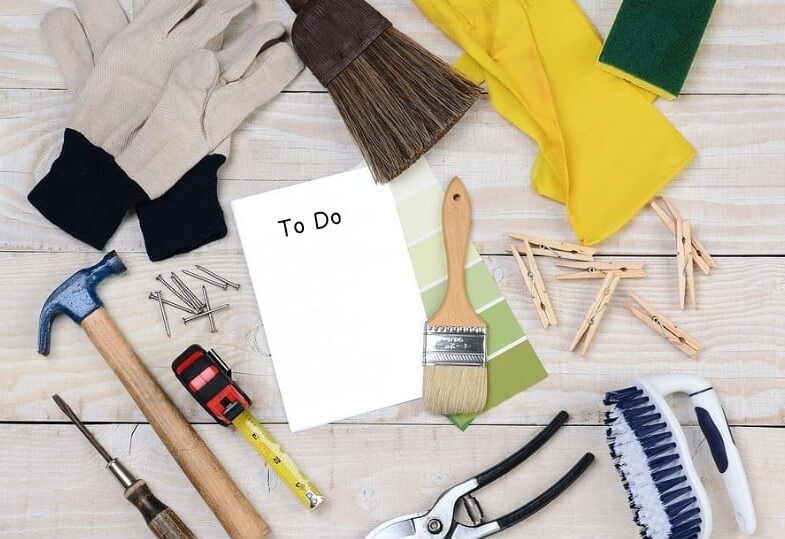Spring Maintenance Checklist for Landlords

After a particularly brutal winter, spring is finally arriving here in the Northeast. Warmer temperatures mean that building owners and landlords should inspect their properties for maintenance issues that might have developed over the winter months. Even if you catch only one minor issue this spring, repairing it now will help protect your investment by preventing a surprise breakdown and/or costly repair later.
Use this checklist to stay on top of your building’s spring maintenance routine.
Outdoor Spring Maintenance Needs
Walk around the perimeter of your property and look at the following areas. Exterior issues will likely deteriorate further in warmer weather, weakening the building’s defenses against the elements.
- Inspect roof and siding. You’ll know your roof is damaged if you look up from the ground level to see a slightly bowed surface or crumbling roofing materials falling into your flowerbeds. Damaged siding materials can also crumble, but siding is more likely to crack or become discolored. Without repairs, roofing and siding damage can lead to water damage and mold growth after spring rainstorms.
- Check gutters and downspouts. In winter, clogged gutters and downspouts expand when they freeze, causing them to warp, crack, or detach from your roof. Walk around the property and look for gutter damage. Keep an eye out for pools of water around the base of your building that are nowhere near a downspout. Damage to gutters and downspouts can lead to a leaky roof or foundation problems.
- Inspect stairs, pathways, wooden decks, and outdoor common spaces. You’re looking for cracks in the sidewalks and stairs as well as wood rot on decks and patios that could become hazards for tenants and guests. Make sure that all fire escapes are in good repair and rust-free.
- Clean exterior vents. Debris can build up around your building’s dryer, bathroom, and range vents. Clearing away any debris will help prevent fires and extend the life of your appliances.
- Clean outdoor HVAC components. If your HVAC equipment has an outdoor component, remove debris from around and inside the unit. An obstructed outdoor unit won’t function as efficiently, causing it to work harder and shorten its service life.
- Check doors and windows. Replace any loose or missing weatherstripping to seal any air leaks. This bit of maintenance can also help keep out pests during the warmer months.
- Inspect exterior faucets. If your building has exterior faucets that haven’t been turned on for a few months, try turning on the tap. Hire a plumber to check for piping leaks if you find low or weak water pressure.
- Prune trees. Branches that were weighed down by snow and ice could be close to falling. Remove weakened branches before summer storms bring high winds.
- Assess curb appeal. Spring is a great time to make sure your building looks its best for existing and prospective tenants. Replace any dead or dying bushes or other plants. If you plant annuals, you can begin as soon as the last frost has passed. Consider pressure washing your building, if needed, and refresh any signage that looks old.
Indoor Spring Maintenance Needs
As you move inside, check for signs that your building’s systems are wearing out. Worn systems can increase your utility bills and create potential safety issues.
- Test smoke and carbon monoxide detectors. Change the batteries in smoke and carbon monoxide detectors, as applicable, and press the “test” buttons to make sure the alarms still sound at a level all residents can hear.
- Check the attic and subterranean areas. Attics, basements, cellars and crawlspaces can become havens for mold and mildew growth in case of roofing or siding leaks. Inspect these areas and check for mildew smells. If you have a sump pump in the basement, make sure it still works.
- Replace HVAC filters. Changing out the air filter in a heating or cooling unit increases its efficiency and extends the service life.
- Test building thermostats. Make sure the thermostats activate the appropriate system when adjusted to a setting other than the current room temperature. Heat season in New York City ends on May 31.
- Inspect piping. A licensed plumber can use specialized tools to find hidden leaks that could increase your water bill or cause water damage. If a tenant ever complains about low water pressure or a soft thumping noise in a wall, contact a plumber as soon as possible.
- Flush the water heater. NYC’s water is considered “moderately hard,” and mineral buildups can slowly reduce your water heater’s efficiency if it’s not flushed regularly. Water heaters (including tankless models) in need of flushing will take longer to heat water. A licensed plumber can flush out any buildups.
- Check for pests. As temperatures rise, so does critter activity. If your building has pests, you might notice a musty odor that won’t go away or small corner nests with droppings nearby. Standard building maintenance, such as sealing cracks and holes, will help keep pests outside as part of an integrated pest management approach.
- Look for water damage. Check common areas and storage rooms for puckering drywall or stains on the walls or ceilings.
- Spruce up common areas. Spring is a great time to deep clean and update building common areas, such as lobbies, laundry rooms and hallways. This investment can also boost tenant satisfaction and retention.
- Update emergency preparedness plans. Review—or create—your emergency evacuation plan; post this information in common areas and share the plan with tenants. Also, review and update required disaster response signage, which provides emergency contact information in residential buildings with non-owner-occupied units.
For more information, check out our year-round maintenance guide for landlords. If you have additional questions about spring maintenance or you’d like a free, no-obligation review of your current building insurance policy, please call us at 877-576-5200.

